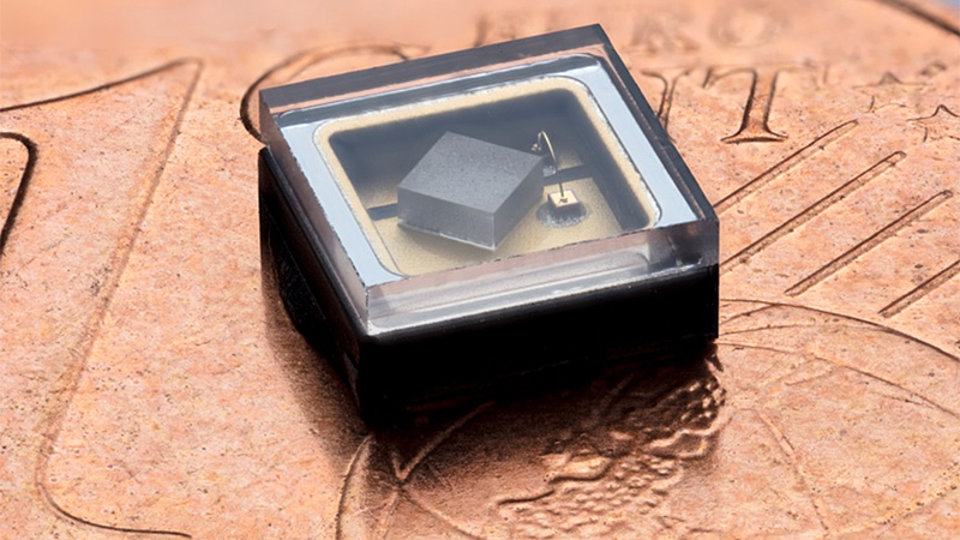Optimized electron blocking layer for UV-B light emitting diodes
Fig. 1. Measured average emission power as well as simulated internal quantum efficiency (IQE) of 310 nm LEDs with different Cp2Mg doping profiles in the EBL. Inset: Typical emission power vs. current characteristics
Fig. 2. Measured average emission power as well as simulated internal quantum efficiency (IQE) of 310 nm with different profiles of the aluminum composition in the EBL. Inset: Typical emission power vs. current characteristics
(In)AlGaN-based light emitting diodes (LEDs) for the ultraviolet B (UV-B) spectral range (280 nm - 320 nm) are promising candidates for replacing established UV light sources in various applications. These include medical diagnostics, phototherapy, and plant growth lighting. However, despite the enormous progress that UV-B LEDs have made their efficiency is still poor, among other things due to relatively high defect densities in these materials. Today, the best UV-B LEDs exhibit an external quantum efficiency of only a few percent. Optimization of the LED heterostructure, especially of the electron blocking layer (EBL), is one way to increase the efficiency of UV-B LEDs. Efficiency of the carrier injection is mainly determined by the Mg-doped AlGaN EBL that prevents electron leakage into the p-doped layers without impairing efficient hole injection into the quantum wells.
We have therefore studied the influence of the EBL doping and EBL material composition on the emission power of LEDs emitting at a wavelength of around 310 nm. LEDs with different EBLs were realized by different temporal Bis(cyclopentadienyl)magnesium (Cp2Mg) and trimethylaluminum (TMAl) profiles during its growth. Fig. 1 shows the averaged measured on-wafer emission power as well as the simulated internal quantum efficiency (IQE) of 310 nm LEDs with different doping profiles. The emission power increases from doping profile 1 to 3 by a factor of around 2.2, with profile 1 corresponding to the lowest and profile 3 to the highest Cp2Mg flow during EBL growth. This effect can be attributed to an improved carrier injection and electron confinement, which is in good agreement with our simulations.
Another key parameter to realize an efficient EBL is its aluminum composition profile. LEDs with a constant, a stepped and a graded aluminum composition in the EBL are compared. The Cp2Mg carrier gas flow during the growth of all samples was kept constant. Fig. 2 shows the averaged on-wafer emission power measured at 20 mA. The highest emission power is achieved from LEDs with graded EBL, closely followed by the LEDs with stepped EBL. The LEDs with constant aluminum content in the EBL show around 30% lower emission power compared to the other two LED types. The measured data is once again in good accordance with our simulations. These show that the electron leakage current is reduced, and the electron concentration in the active region is enhanced for the LEDs with graded and stepped EBL. Additionally, these two LED types show only a 28 meV high potential barrier for the holes in the valence band at the upper EBL interface. In contrast, this potential barrier is around 189 meV for the LED with the constant EBL, which leads to an accumulation of holes and a reduced hole injection into the active region.
By further optimizing the LED heterostructure and chip design, the LED performance has been further improved. The emission power of packaged UV-B LEDs operated at 20 mA and 350 mA has been increased to more than 2.5 mW and 30 mW, respectively (Fig. 3).
This work was partially supported by the German Federal Ministry of Education and Research (BMBF) through the consortia project "Advanced UV for Life" under contracts 03ZZ0134B, 03ZZ0130A and 03ZZ0105A.
Publication
T. Kolbe, A. Knauer, J. Rass, H. K. Cho, S. Hagedorn, S. Einfeldt, M. Kneissl, M. Weyers, "Effect of Electron Blocking Layer Doping and Composition on the Performance of 310 nm Light Emitting Diodes", Materials 10, 1396 (2017).



